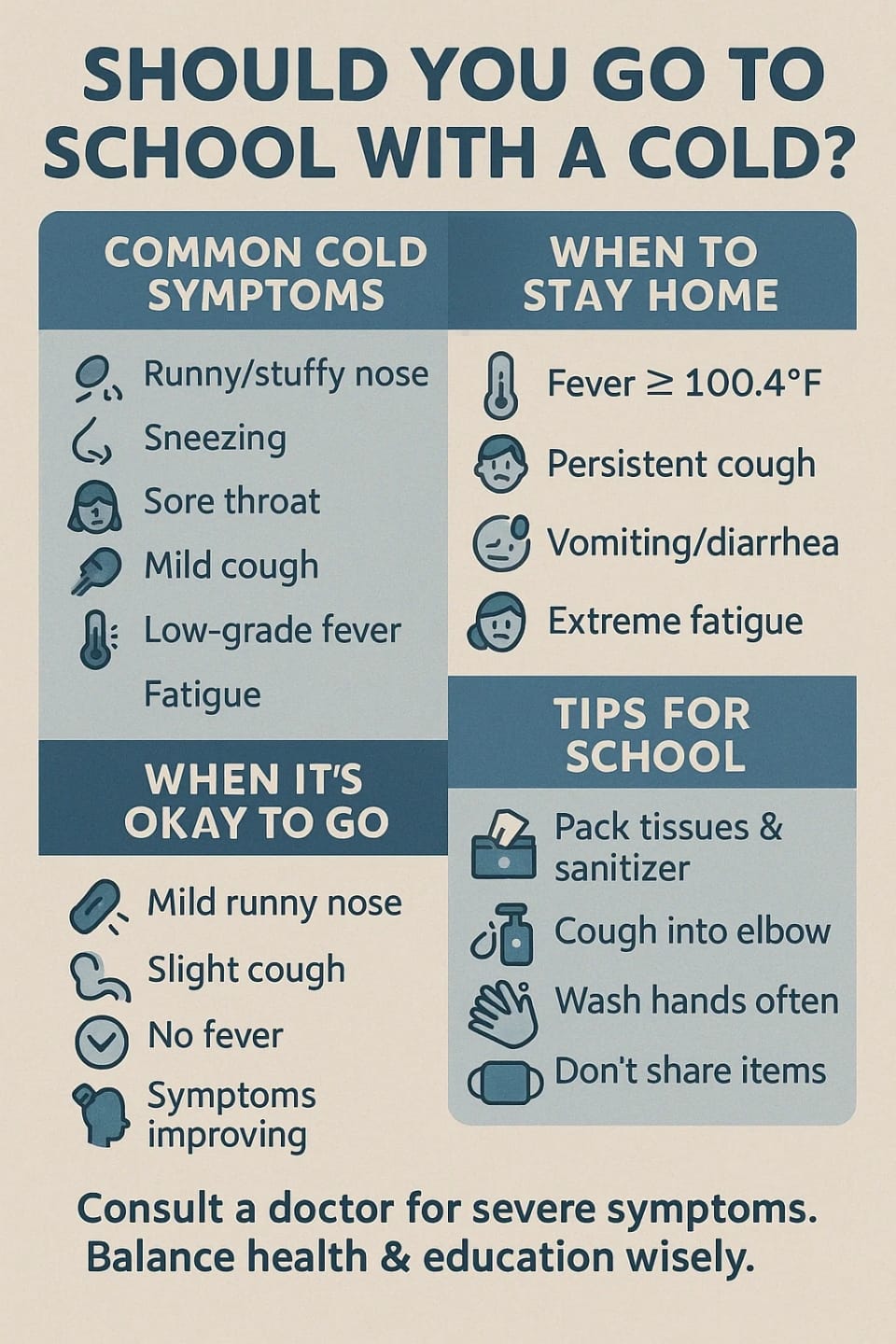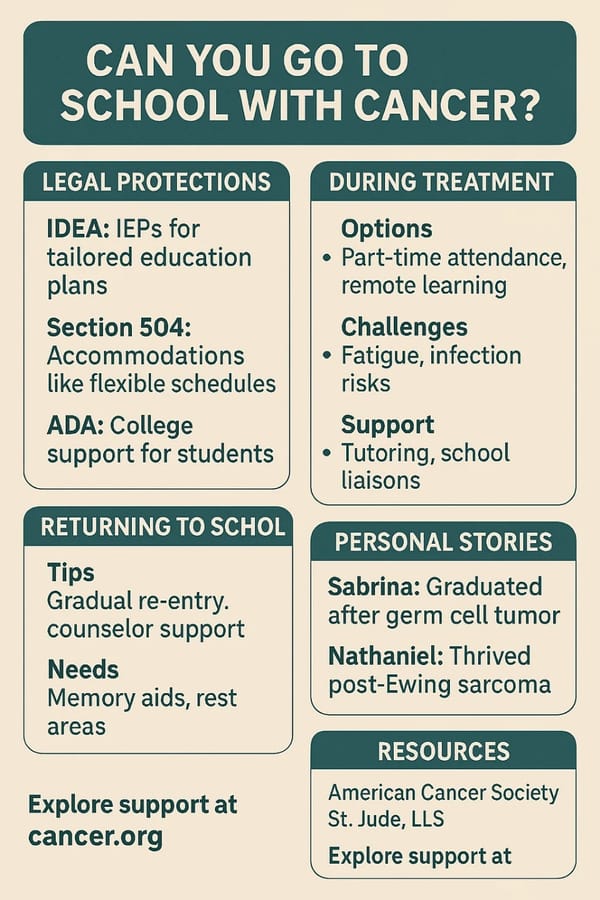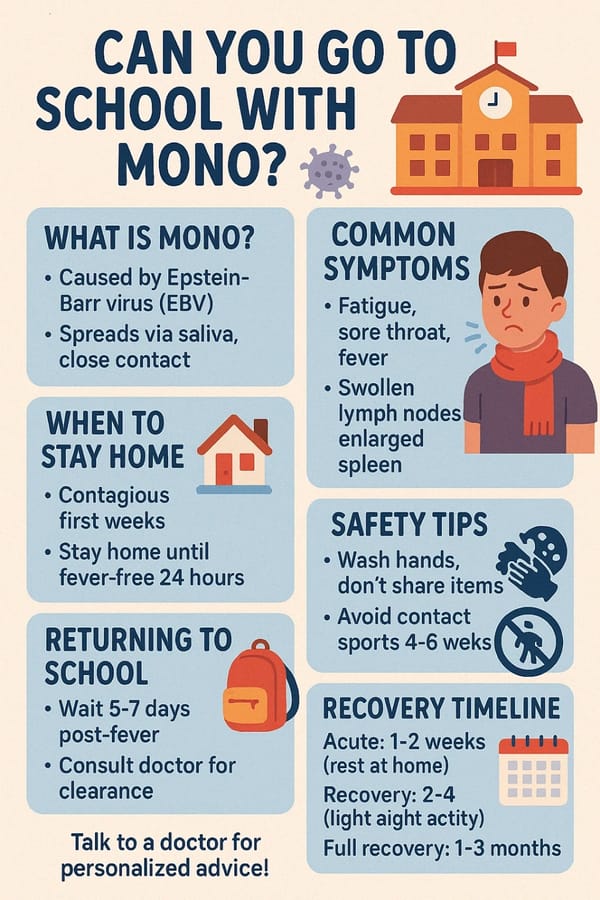Should You Go to School with a Cold? A Comprehensive Guide for Parents and Students
Picture this: your child wakes up with a stuffy nose and a slight cough. They’re not that sick, but you’re torn. Should they go to school with a cold? It’s a question every parent and student faces at some point, especially when cold season hits and classrooms turn into sniffle central. You don’t want to derail their education or yours, but you also want to keep germs in check and avoid making things worse. Deciding whether to attend school during a cold is a delicate balance of health concerns and academic responsibilities.
In this comprehensive guide, we’ll dive deep into everything you need to know about going to school with a cold. From recognizing symptoms and navigating school policies to practical health tips, we’ll arm you with expert-backed advice to make the right call. As a parent who’s wrestled with this choice for my own kids, I’ll share personal insights to keep it real and relatable. Whether you’re a worried parent, a student weighing your options, or a teacher curious about best practices, this article will help you evaluate the pros and cons and decide what’s best for everyone involved.
Why the Decision to Go to School with a Cold Matters
The choice to send a child—or yourself—to school with a cold isn’t just about one day’s attendance. It’s a decision that ripples through health, education, and even the classroom community. Colds are a leading cause of school absences, with millions of cases reported annually among American children, according to the National Institutes of Health. Keeping a student home for every sneeze could mean missing weeks of school each year—an impractical choice for most families. But sending someone to class while sick risks spreading the virus to classmates and teachers, potentially disrupting entire classrooms.
The stakes are high. Missing school can dent academic performance, as even a single day’s absence makes it harder to keep up, per an AP News report. On the other hand, attending school with a cold can stretch recovery time and sap focus, leaving students struggling to participate. This guide will unpack the key factors—symptom severity, school rules, and health impacts—to help you make an informed decision.
Understanding the Common Cold: Symptoms and Contagiousness
What Is a Common Cold?
A common cold is a viral infection, typically triggered by rhinoviruses, that targets the nose and throat. According to Community Health Centers, adults catch about 2–3 colds per year, but kids often get more due to their still-developing immune systems and frequent close contact in schools. Common symptoms include:
- Runny or stuffy nose
- Sneezing
- Sore throat
- Mild cough
- Low-grade fever
- Fatigue
These symptoms usually kick in 1–3 days after exposure and can linger for up to two weeks.
How Contagious Is a Cold?
Colds spread like wildfire through respiratory droplets from sneezing or coughing, or by touching contaminated surfaces like doorknobs, shared pencils, or desks. The CDC’s school preparedness page notes that people are most contagious in the first 2–3 days of symptoms, though they can spread germs for up to a week. Schools, with their crowded classrooms and communal supplies, are prime hotspots for transmission.
When Is a Cold More Than a Cold?
Not every sniffle is just a cold. Symptoms can sometimes mask more serious conditions like the flu, strep throat, or even COVID-19. The AdventHealth guide on colds and flu points out that flu symptoms tend to hit harder, with high fevers, body aches, and intense fatigue. If you notice signs like difficulty breathing, a persistent fever, or a worsening cough, it’s time to see a doctor pronto.
Should You Go to School with a Cold? Key Factors to Consider
Deciding whether to head to school with a cold means weighing several factors: how bad the symptoms are, what your school’s rules say, and how it might affect health and learning. Let’s break it down step by step.
1. Symptom Severity: When to Stay Home
Not all colds are equal. A mild sniffle might not derail your day, but severe symptoms can make learning tough and spread germs faster. Here’s a quick guide based on expert advice:
-
Stay Home If:
- You have a fever of 100.4°F or higher. The CDC’s school health guidelines recommend staying home until you’re fever-free for 24 hours without meds.
- You’re dealing with vomiting or diarrhea (more than two episodes in 24 hours), according to Harvard Health’s school absence guide.
- A persistent cough disrupts sleep or class, as noted by Children’s Healthcare of Atlanta.
- You’re too exhausted or miserable to participate in school activities.
-
Okay to Go If:
- Symptoms are mild—like a runny nose or slight cough—and you can still focus, per the American Academy of Pediatrics.
- There’s no fever, and symptoms are improving, according to the Cleveland Clinic’s sick day guide.
Personal Experience: I once sent my daughter to school with a runny nose but no fever, arming her with tissues and a handwashing pep talk. She breezed through the day and didn’t spread her cold. But when my son had a relentless cough that kept him up all night, I kept him home to rest. Two days later, he was back in class, good as new.
2. School Policies on Illness
Most schools have clear rules about when to stay home. For instance, the Los Angeles Unified School District allows students with mild symptoms like a runny nose to attend but requires staying home for fever, vomiting, or severe pain. Policies vary, so check your school’s handbook or website for specifics.
Some schools ask for a doctor’s note after extended absences, but the CDC warns this can strain families and healthcare systems. Unsure about the rules? A quick call to the school nurse can clear things up.
3. Impact on Learning and Health
A cold can mess with your head—literally. It impairs concentration and memory, making it harder to learn, according to Community Health Centers. If you’re too wiped out to participate, staying home for a day or two might be smarter than slogging through. On the flip side, missing too many days can lead to academic setbacks, especially during high-stakes times like exams or project deadlines.
Health-wise, pushing through a cold without rest can slow recovery or, in rare cases, lead to complications, especially for those with weakened immune systems. The National Institutes of Health points out that colds can sometimes escalate to serious conditions like pneumonia in vulnerable groups.
4. Preventing Germ Spread
If you do go to school, take steps to keep germs in check. The AdventHealth guide suggests:
- Sneezing or coughing into a tissue or your elbow.
- Washing hands often with soap and water.
- Avoiding sharing items like pencils, water bottles, or snacks.
| Symptom | Stay Home? | Go to School? | Notes |
|---|---|---|---|
| Fever (100.4°F or higher) | Yes | No | Stay home until fever-free for 24 hours without medication. |
| Runny Nose | No | Yes | Okay if mild and manageable; use tissues and wash hands. |
| Persistent Cough | Yes | No | Stay home if it disrupts sleep or class; see a doctor if it worsens. |
| Fatigue | Maybe | Maybe | Stay home if too tired to participate; otherwise, attend with precautions. |
| Vomiting/Diarrhea | Yes | No | Stay home until symptoms stop for 24 hours. |
Practical Tips for Managing a Cold at School
If you or your child heads to school with a mild cold, these tips can help manage symptoms and stop germs from spreading:
- Pack Smart: Bring tissues, hand sanitizer, and a water bottle to stay hydrated. Lozenges can soothe a sore throat, but check school rules first.
- Reinforce Hygiene: Remind kids to cough into their elbow and wash hands often. The UK Health Security Agency stresses that good hygiene slashes virus spread.
- Talk to Teachers: Let the teacher know about the cold so they can keep an eye out for worsening symptoms or offer support, like seating the student apart from others.
- Stay Flexible: If symptoms ramp up during the day, be ready to pick up your child. Schools often require immediate pickup for fever or severe issues.
- Boost Immunity: A healthy diet, solid sleep, and regular exercise strengthen the immune system, as noted by Around the Kampfire’s teacher health tips.
Personal Experience: I sent my son to school with a mild cold once, only to get a call from the nurse by lunch because he’d spiked a fever. Now, I slip a note in his backpack with my contact info and a reminder to call if he feels worse. It’s a small trick that saves stress.
When to Seek Medical Advice
Most colds fade on their own, but some symptoms scream for a doctor’s attention. Reach out to a healthcare provider if:
- A fever lasts over five days or hits 104°F, per the Cleveland Clinic.
- You notice trouble breathing, persistent coughing, or ear pain.
- Symptoms drag on past 10–14 days or get worse after seeming to improve.
For kids with conditions like asthma or weakened immune systems, check with a doctor before school, as colds can spark complications, according to Community Health Centers.
Balancing Education and Health: A Parent’s Take
As a parent, I get how tricky this decision is. Missing a day of school might mean juggling work or scrambling for childcare, but sending a sick kid to class can backfire big time. I’ve learned to trust my gut—if my child looks wiped out or can’t stop coughing, I keep them home, even if it’s a hassle. A day of rest often gets them back to school faster and keeps the classroom healthier.
The University of Utah Health nails it: kids don’t learn well when they’re sick, and staying home protects everyone. It’s a small price to pay for the bigger picture.
Conclusion: Making the Right Call
Deciding whether to go to school with a cold boils down to a few key questions: Are the symptoms mild enough to handle? What does the school say? And can you stay focused without spreading germs? Mild issues like a runny nose or slight cough are often fine with precautions like tissues and handwashing. But fever, relentless coughing, or extreme fatigue? Those are red flags to stay home and rest.
Armed with expert advice, school policies, and practical tips, you’re ready to make a choice that balances health and education. Next time you’re on the fence, ask: Can I—or my child—learn and participate without risking others? If yes, grab those tissues and go. If not, a cozy day of recovery might be the best move. Got a go-to tip for handling colds during the school year? Drop it in the comments—we’d love to hear it!






